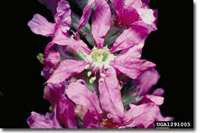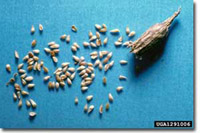|
 Access For All
Access For All
|

|

Purple loosestrife bloom stalks
Photo by K. L. Kyde, 2006 |
Facts About Purple Loosestrife
What is it?
Purple loosestrife (Lythrum salicaria) is a highly invasive non-native plant that threatens
significant portions of Maryland's marsh, swamp, and coastal habitats. By
crowding out native wetland species, purple loosestrife can reduce
biodiversity, eliminate food sources for marsh animals and change water flow
patterns.
The Department of Natural Resources (DNR), in partnership with the Maryland
Department of Agriculture (MDA) and the State Highway Administration (SHA), has begun a
program to identify, treat, and ultimately eradicate purple loosestrife within
our state. We need your help in order to make this effort a success.
|
How can I recognize it?
Purple loosestrife is a tall, branching perennial herb that grows in moist or
marshy areas. It can grow to be 8 feet high. In July, it has long spikes of
bright purple-pink flowers at the top of the plant. |
|
The 1” flowers have 6 pink petals and yellow-white centers. The leaves are long
and narrow with pointed tips and smooth edges. They are opposite (two at each
joint) and are attached directly to the stem. The stems of purple loosestrife
are square and slightly fuzzy. You can feel these edges if you try to roll the
stem between your fingers. |
|

Close-up of purple loosestrife flowers.
The 1” flowers have 6 pink petals and yellow-white centers.
Photo courtesy of Linda Wilson, University of Idaho
|

The tiny seeds of purple loosestrife develop in a capsule less than 1"
long. One plant can make over 2 million seeds.
Photo
courtesy of Linda Wilson, University of Idaho
|

Purple loosestrife has square and slightly fuzzy stems and opposite leaves.
Photo courtesy of Richard Bean,
MD Department of Agriculture
|
|

Seed capsules on a stalk
of purple loosestrife.
Photo courtesy of K. L. Kyde, 2006 |
After the flowers are finished,
purple loosestrife develops hundreds of small sharp-pointed capsules that
contain thousands of tiny golden-brown seeds. From a distance, these
capsules make the plant look reddish brown at the top. You can print our
handy guide with pictures and the key characteristics to help you identify
purple loosestrife in the field.
Purple Loosestrife Field Guide
How did it get here?
Purple loosestrife was introduced to eastern North America from Europe and Eurasia in several ways. Seeds and plant parts were transported accidentally in the ballast water of 19th century sailing ships. Seeds adhered to raw wool and to sheep that were imported by the early colonists.
Purple loosestrife was also used as a medicinal plant and so was brought by the colonists to plant in their gardens in the New World. Cultivated varieties were also brought from Europe to enhance American gardens. |
|
Why is it a problem?
Purple loosestrife spreads by seed but also by new roots sprouting from
broken pieces of stem or roots. After it is established in a new area,
especially a disturbed area, it can spread rapidly in moist environments. Left
unchecked, purple loosestrife can form uninterrupted stands, called
“monocultures”, that crowd and shade out native wetland species like cattails
and rushes.
The native insects, birds and mammals that feed and reproduce in marshes
cannot use purple loosestrife as they can the native species they are
accustomed to, so food webs and reproduction cycles are disrupted. Marsh wrens
and muskrats leave purple loosestrife infested areas to find cattails, for
instance. Some of the species that use marsh systems are very rare, so that
preserving intact native habitat is extremely important for them.

American bittern and Bog turtle are two rare species
that can be affected by purple loosestrife invasions.
Photo of American Bittern courtesy of John White
& photo of Bog Turtle
courtesy of Scott A. Smith
Dense purple loosestrife stands can impede boat traffic, obstruct hikers and make it hard for bank fishermen to reach the water. As purple loosestrife spreads, it can change patterns of water flow, catching silt and shedding plant detritus that builds up marsh elevations, or clogs drainage systems. In parts of Maryland where wet meadow hay is grown, purple loosestrife can invade hay fields and reduce the purity and yield of salt hay.
How Can We Manage It?
|
 |
|
US Fish and Wildlife Service restoration
in a marsh invaded by purple loosestrife
Photo courtesy of USFWS
|
|
|
Because Maryland does not have the huge infestations of purple loosestrife that New York, New Jersey or Minnesota do, we have a realistic chance of controlling this invader before it spreads widely and does extensive damage to our Chesapeake Bay wetlands. Other parts of the country have been fighting its spread for decades, sometimes with great success,
while in other areas purple loosestrife has been able to dominate.
We plan to search for the plant, identify it, report and map its locations, and use one of three methods to reduce or completely remove infestations. That’s where you can help!
|

Purple loosestrife infestation
in southeastern Minnesota.
Photo courtesy of Linda Haugen,
USDA Forest Service
|

Typical purple loosestrife infestation in a Maryland roadside drainage ditch.
Photo courtesy of K. L. Kyde, 2006
|
|
|
|
 |
We are training Maryland residents who spend time outdoors in habitats where
purple loosestrife may grow to recognize the plant and report its locations
to DNR using an on-line or paper reporting form. Those who take
photographs in the field are also encouraged to photograph the Purple
Loosestrife they have located and include these in your report. When those locations are mapped and assessed, we will control the populations -- removing them by hand, by careful use of safe herbicides or by releasing a beetle that eats only purple loosestrife.
For more information about the beetle,
visit the website of Phillip Alampi in NJ Beneficial Insect Laboratory:
http://www.state.nj.us/agriculture/divisions/pi/prog/biological.html#8
http://www.nysaes.cornell.edu/ent/biocontrol/weedfeeders/galerucella.html |
Tiny Galerucella beetles offer documented biological control of
purple loosestrife.
Photo courtesy of USFWS |
|
What Can You Do?
Become a Loosestrife Scout!
Come to a training session and learn how to recognize purple loosestrife, how to complete the reporting form and how to tell us about it.
If you are able to take photographs (digital or print), these can also be
included in your report. Hikers, bikers, boaters, birders and fisherman
are becoming Loosestrife Scouts. These citizen scouts act as our eyes and ears within the state, especially along its miles of coastline and river and tributary banks, informing us whenever they spot the invasive plant, so that we can remove it.
Help us remove the invader!
Join DNR and MDA personnel and other volunteers for hand removal projects on small infestations, when we pull or dig out entire purple loosestrife plants and dispose of them safely. We’ll provide the tools and snacks; you provide the labor. These projects will continue through the summer at locations on public land where loosestrife is found – watch this site for the schedule and the chance to come help!
If you spend time on Maryland’s public lands and DO NOT see purple loosestrife, that information is as important to us as when and where you do see purple loosestrife. To be able to map the populations within the
state, we need to know where purple loosestrife is, but also where it isn’t. Fill out a reporting form to let us know what you see or don’t see, either way.
Don’t grow this plant in your garden!
For many years, we thought that there were sterile cultivated varieties of purple loosestrife. But researchers have found that seemingly sterile cultivars will cross pollinate with other cultivars or with purple loosestrife growing in the wild, and can produce pollen or seed. Garden plantings of
purple loosestrife can thus add to the spread of this invasive plant. There are a number of native and non-invasive landscape plants, like salvia or gayfeather, that can replace purple loosestrife in the garden.
|
|
|
|
For More Information
To learn more about this project or to become a Loosestrife Scout, please email or call us:
Kerrie L. Kyde
Invasive Plant Specialist
kkyde@dnr.state.md.us
Phone: 301-948-8243
Habitat Conservation
Wildlife and Heritage Service
Maryland
Department of Natural Resources
11960 Clopper Road
Gaithersburg, MD 20878
Bob Trumbule, MDA Entomologist
301-982-3224
|
 This website was developed in part with financial support from a National
Fish and Wildlife Foundation "Pulling Together Initiative" grant. This website was developed in part with financial support from a National
Fish and Wildlife Foundation "Pulling Together Initiative" grant. |
|



